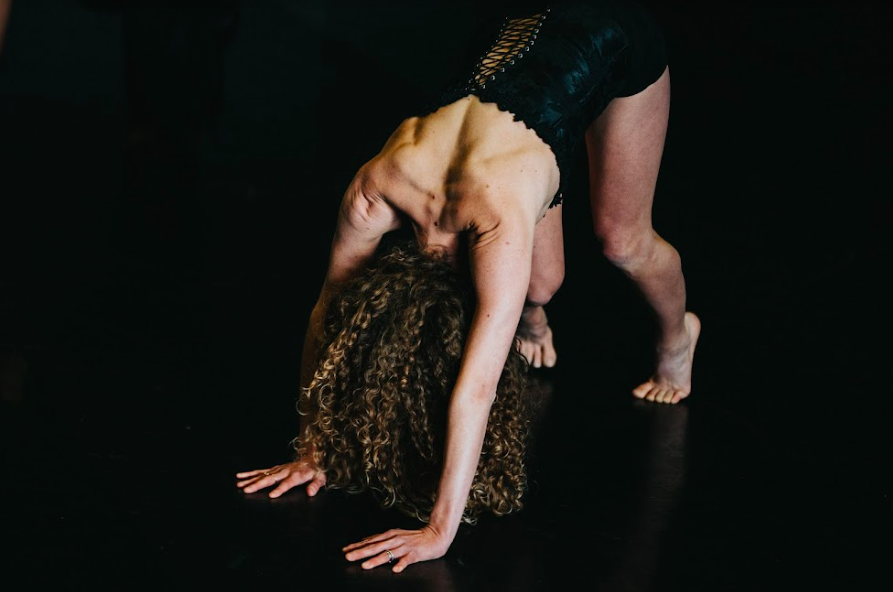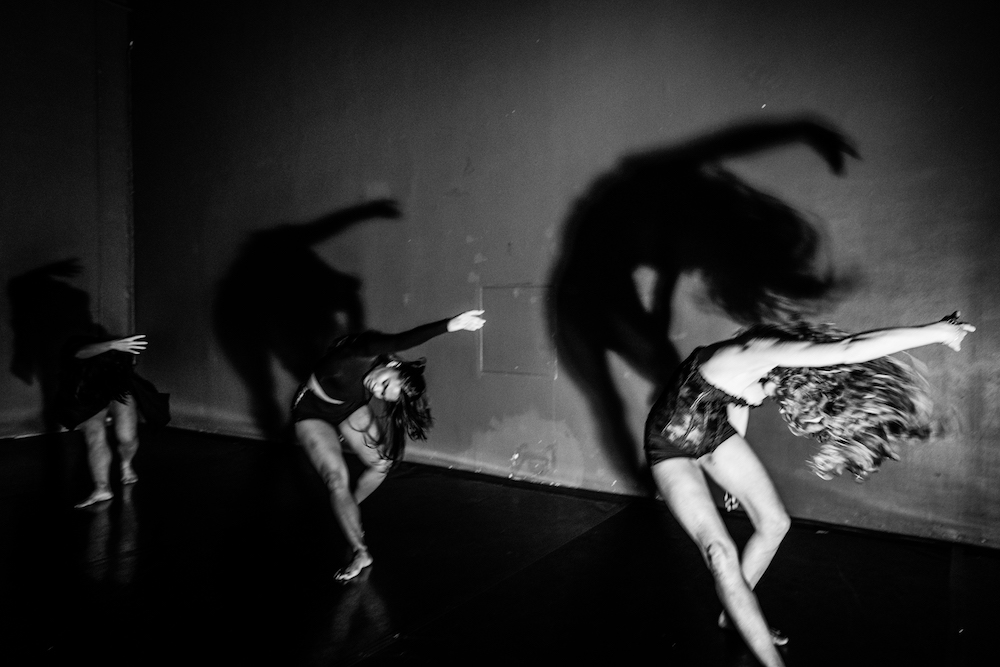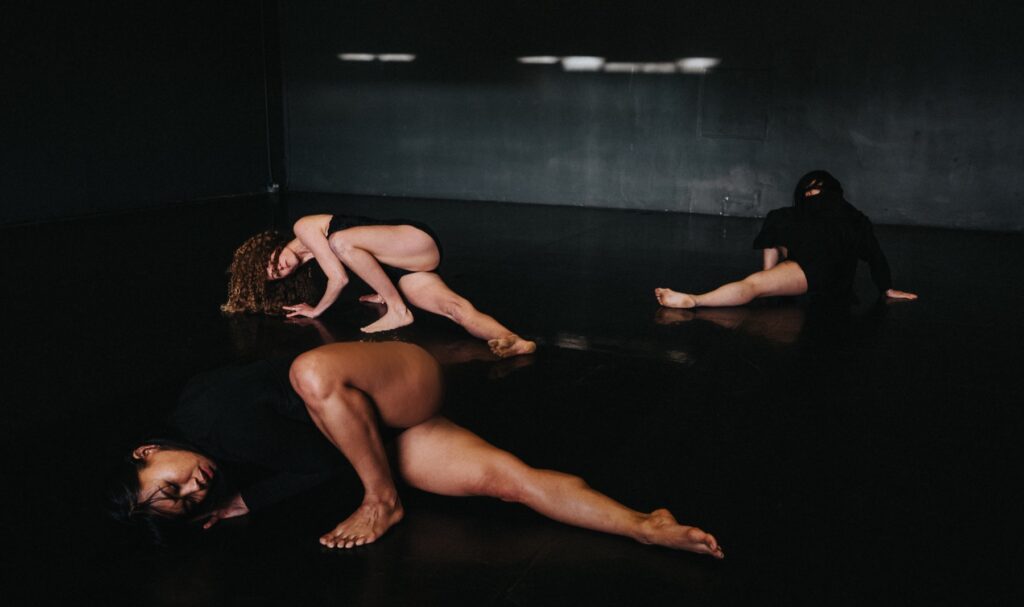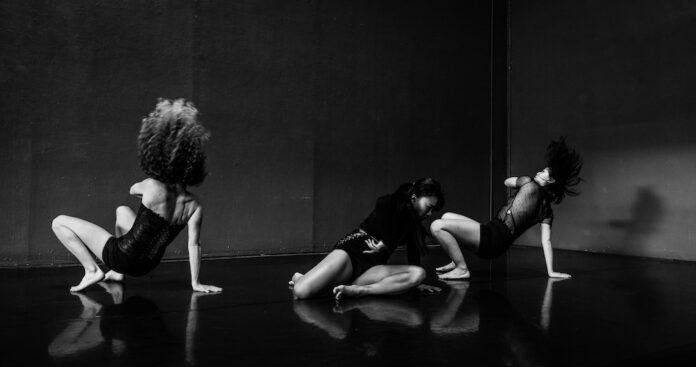Have you ever sat next to a bad audience member who, paradoxically, proved the point being made in the show you’re watching? I’m sure it’s happened to me before, but I can’t recall off-hand. It most certainly happened during the opening night of choreographer Hope Mohr’s Horizon Stanzas (world premiere ran April 27–30 at the Joe Goode Annex.) My seat was behind a cranky old white man who spent much of the hourlong run time shuffling in his seat and vocally harrumphing through this unabashedly feminist work, which was based on 1992’s book-length epic poem The Descent of Alette by Alice Notley.
I have no idea who the guy was, nor what bee flew in his boxers at that moment, but every time the infrequent narrator (voiced by Mohr) spoke of an oppressive masculine force, I kept thinking she meant the cantankerous old grouch in front of me.
Not having read The Descent of Alette, my understanding of its narrative comes only from this play. Our unnamed femme narrator (personified by dancers Belinda He, Suztte Sagisi, and Tegan Schwab-Alavi) is clearly in an abusive (emotionally and mentally, if not physically) relationship with a man she calls The Tyrant. So controlling is The Tyrant that the narrator has no identity away from him.
“Did he invent me?” she asks. “The Tyrant owns my form.”

I wondered if The Tyrant was a specific man or institutional misogyny in general.
A recurring motif in the piece is the imagery of an owl. It’s frequently used to show the presence of power, intoxicating when possessed. The dancer wearing the foldable (3D-printed?) white mask by Ella Noe is given control over the other two, who perform for the owl’s approval. It isn’t clear if the owl represents The Tyrant, the Narrator impersonating The Tyrant, or both, but the shift from powerless to powerful is crystal clear. It’s terrifying to think that if we had the power of our oppressors that we might behave in a similar fashion.
And make no mistake: Mohr’s three dancers are meant to embody power dynamics and expectations applied to the femme body. It’s rare that they express any pure joy, as they’re frequently crawling like pets attempting to please their guardian. They do attempt to find rhythmic solace in the soundtrack’s two pop music interludes—Chicks on Speed’s “Warm Leatherette” and The White Stripes’ “Blue Orchid”—but the same soundtrack (no sound designer is credited) also creates a subtle atmosphere of loneliness for our Narrator by surrounding her with city sounds like train passengers, restaurant patrons, etc., that are little more than wallpaper to a woman possessed.

Lest that point not already be made clear, Del Medoff’s lights (a combination of spots, overheads, and hanging solitary bulbs) drives it home further. Occasional blackouts are broken by someone unseen slowly “chasing” one of the terrified dancers along the perimeter of the black box theatre like a serial killer. One truly striking image uses forced perspective to have one dancer—no doubt meant to be The Tyrant—presented as a gigantic shadow dominating their pixie-small companion.
Help us save local journalism!
Every tax-deductible donation helps us grow to cover the issues that mean the most to our community. Become a 48 Hills Hero and support the only daily progressive news source in the Bay Area.
That’s the point of abuse: make the other person feel small, powerless, and completely invisible without you there to provide the attention they need.
Mohr and her collaborators keep the “narrative”—such as it is—moving at a reasonable pace as the three deliver fine performances. They find the humor and sadness of their shared identity; from a chest-high cupped-hand gesture that accompanies marionette-like movements across the stage to the on-a-dime turns from fast to slow, as if reacting to the ever-changing mood of someone not there. One could watch the three perform Mohr’s steps all day, but knowing they’re enacting an abusive relationship makes you hope that it will end soon. No one should have to stay in harm’s way if they don’t have to.

Speaking of which: one is pleased to know that the Joe Goode Annex requires all patrons to be masked inside the building as well as vaccinated before entering. (I wish the latter stipulation was based on physical cards and QR codes rather than allowing photos of cards, but that seems a tall order these days.) Aside from two patrons who made it all the way to their seats before finally putting on masks, the audience stayed covered throughout the hour. CO² readings on my Aranet4 topped out at 1235ppm, which I oddly consider low, given the readings I’ve gotten at other venues.
As an adaptation of The Descent of Alette, I can’t speak to the dance’s narrative fidelity. As a physical performance telling the story of a woman possessed rather than loved, it was a gripping hour of theatre. Modern dance prides itself on being far more visceral than its classical forebearers, and that’s clear even when there isn’t an explicit act of violence being portrayed. The great thing about art is that there’s an intentional distance created from what’s shown and what’s experienced. At the end, we at least have the benefit of leaving, like an owl taking flight.
HORIZON STANZAS premiere ran through April 27–30. Joe Goode Annex, SF. Further info here.





